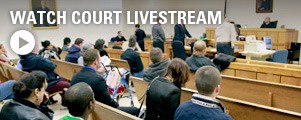New York Times: ‘Open Up High Court to Cameras’

Above: students camp out in front of the Supreme Court of the United States in April 2010. — "Staying Warm" on Flickr
The U.S. Supreme Court begins a new term this week. We were pleasantly surprised to see an Op-Ed in the New York Times this weekend advocating for the highest court in the land to open their chambers to video cameras.
Currently, the only way you can hear the oral arguments of the Supreme Court is to wait outside the court for the chance to snag one of the 250 seats in the public gallery. The dedicated sometimes camp out overnight, occasionally in snowy, below-freezing weather, to see the proceedings in what is supposed to be an open court.
If you miss the cut-off for the full two-hour hearing, you can hop over to the “three-minute line,” where you can get a feel of what the court is like but little more.
To the New York Times, this isn’t equal access to the law.
“Equal justice under law” is the inscription on the face of the court building. It is time that we the people had equal access to the process by which that justice is meted out.
The benefits of increased access and transparency are many. Democracy’s first principles strongly support the people’s right to know how their government works. This would seem to be underscored by this court’s stubborn insistence on freedom of communication in a democratic society. Recall that earlier this year, the court held that the First Amendment protected the right of protesters to hector a military family during a funeral service for their son, who was killed in Iraq. And the court decided that the same societal interest in free speech outweighed California’s interest in protecting minors from extremely violent video games. These are but two of many examples in which the current court has made plain its view that, in extreme cases, the force of First Amendment rights shall outweigh all else.
The laboratories of democracy
We are supporters of this idea as well. We believe bringing digital technology into courtrooms will allow the public to follow cases that have an impact on their lives, to verify that justice is being administered correctly, and to help them to understand how the justice system works.
As you might know, we’re in the middle of a court case that involves our First Amendment rights as a news organization as it applies to live-streaming a district court. The case, Commonwealth vs. Barnes, has gone up to the Massachusetts Supreme Judicial Court (SJC), to be heard on November 8th.
Luckily, state courts truly are the laboratories of democracy, as early 20th century Supreme Court Justice Louis Brandeis said, and the oral arguments of the hearing will be live-streamed by the SJC, in cooperation with Suffolk University Law School.
So, on November 8th at 9 am, if you can’t make it down to the courthouse, you can click on the hearing and watch it in its entirety. And if you can’t watch right away, the archives remain online.
The Massachusetts SJC is one of 27 state Supreme Courts, plus the Court of Appeals in D.C., that have webcasts that stream the oral arguments of the court live, according to the Radio Television Digital News Association (RTDNA). Some stream video and audio, some only audio, and many make the archives available afterwards.
The RTDNA too believes that the Supreme Court should open itself to cameras.
“While the Supreme Court is the arbiter of our constitution and our First Amendment rights, it also remains the least transparent of all government branches. This should change,” said RTDNA Chairman Kevin Benz. “The Court opened its doors to the public many years ago but has steadfastly refused to allow the unlimited seating television cameras would bring to those who cannot attend in person. Citizens of the United States deserve to hear the arguments being made in cases directly related to our individual and collective freedoms.”
Again, the New York Times:
Year after year, the court issues decisions that profoundly affect the nation. Think of civics classes. The retired Justice Sandra Day O’Connor is one of many who have lately lamented the apparent collapse of civic literacy in public schools. Think of older Americans affected by President Obama’s health care program. Think of women or other groups affected by important class-action cases, like the Wal-Mart discrimination case last term. These citizens should have a chance to hear what the justices think about important questions that touch their lives.
Lately, the Times has come out with several editorials supporting open and transparent courts, one supporting the release of a video recording of the civil trial on the constitutionality of Proposition 8, California’s ban on same-sex marriage, and another criticizing the increase in sealed court records in the Supreme Court and advocating for a clear rule that would preserve the presumption of openness.
In the latter, they wrote:
Informed self-government is essential to a healthy democracy. The First Amendment’s guarantees of free speech and press are intended to ensure that. It is important that the Supreme Court’s rules reflect its long-stated preference for the open administration of justice.












Couldn’t agree with you more, but how about locally.
Currently the Massachusetts Supreme Judicial Court is captured on video, but not the Appeals Court!
Why not.
Although I realize that our government will always find the most expensive way to do things, given the falling cost of this function I have to wonder how expensive it can be.
While the OpenCourt project has improved justice in one courtroom in Massachusetts, there are many more courtrooms in Massachusetts that need the same public scrutiny.